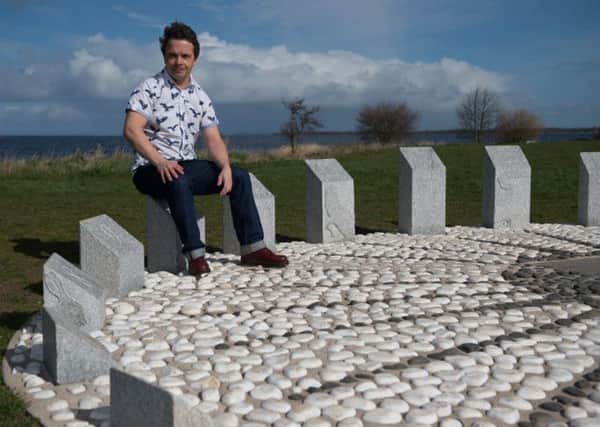Talented Lurgan stone carver spend two and a half years meticulously creating a splendid range of intricately chiselled pillars


A unique piece of art - Jonny spent years meticulously carving pieces of granite left over from the regeneration of Lurgan’s streets into a specialist time piece that will endure for centuries.
The sundial is aptly situated on the southern shores of Lough Neagh at the Oxford Island Nature Reserve where Jonny has worked for many years.
Advertisement
Hide AdAdvertisement
Hide AdJonny is a self-taught carver, working first in wood then in stone. “As a lifelong nature lover it gave me another excuse to go walking in wild places, in search of raw materials for my work. I’m forever coming home from trips with wood or stone souvenirs for carving.
He has been inspired by artists like Brancusi and Hepworth, as well as Celtic, Mayan, Egyptian artefacts, stone was a natural progression from wood. “The physical challenge is part of the attraction to stone carving. The Oxford Island Human Sundial nearly broke my back, taking around two years to carve! But the longevity of the finished piece is the stone-carver’s reward.” Jonny started by making computer drawings for the only analematic sundial in Ireland.
“It’s a fantastic site for a sculpture, right beside the Lough, and when it’s finished, many thousands of visitors young and old will see the sundial over the Summer months.
“It’s rough-grained Chinese granite, and cutting through it was tough going, It takes diamond cutting wheels, tungsten carbide tipped chisels, and a whole lot of hard work and patience. It’s always a good moment when the stone finally splits in two.”
Advertisement
Hide AdAdvertisement
Hide Ad“The shades of grey in the stone will sit well beside the Lough, which on dull days is coloured many beautiful shades of silver and grey.”


There are 16 upright stones in all, each inscribed with the hours of daylight in Summer between 6am and 9pm.
“It takes years or even centuries for rivers and seas to wear granite down. Thanks to grinders and polishers the process is a bit quicker these days. Working in stone takes patience, but its longevity is the carver’s reward. Hopefully the Oxford Island stones will still be there long after I’m gone.
“I start off the numbers with printed paper stencils, tracing the outline onto the stone. I chose a Roman style font for the numbers, as its lines are well suited to this type of traditional V-cut carving. Even on a dull day, when the shadows disappear, the contrast between the polished flat face, and the matt finish left by the chisel, helps to make the numbers stand out.”
Advertisement
Hide AdAdvertisement
Hide AdJonny has carved an intricate display of animals on the stone pillars in a low relief, a technique which largely relies on the creation of shadow and lights to describe form, rather than truly three-dimensional masses and negative spaces as is the case with sculpture in the round.
“One of the first animals I carved was the Devils Coach Horse beetle. On a dull day, shadows disappear and the animals fade back into the stone, as if camouflaged in their environment. On a sunny day, the shadows return and the animals appear more clearly.”
One side of the stones shows water-based animals backed by the Lough. The other side shows land-based animals, backed by the woods.
The major drawback of siting a sundial in Ireland is, of course – the rain! Since Jonny carves outdoors, rain stopped work many, many times.
Advertisement
Hide AdAdvertisement
Hide AdIndeed he worked in freezing cold through dark nights rushing to get the sundial finished for installation in Spring 2013.
However, planning and red tape delayed the installation until September 2014.
Terry Moseley of the Irish Astronomical Society took care of the calculations needed to make sure the sundial would work properly. And with the help of Sandra from Craigavon Council Conservation Team the push was on to erect the sundial.
“And after all the back breaking toil, and brain-hurting calculations, I am very glad to say, it works,” said Jonny.
Advertisement
Hide AdAdvertisement
Hide Ad“So, next sunny day you’re at Oxford Island, stand on the correct date, with your feet either side of the central date line. Now raise your hands in the air and tell the time, and maybe think for a minute about our place on the planet, in the solar system.”